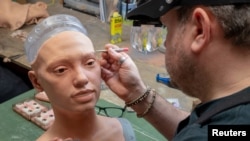Can robots be creative?
British art gallery owner Aidan Meller thinks so. He hopes to begin answering that question with a robot called Ai-Da.
Meller is overseeing the building of all her parts by engineers at Engineered Arts, a company based in Cornwall, England. The engineers believe the robot will be able to make pictures of people from sight with a writing instrument in her hand.
Ai-Da is named after the British mathematician Ada Lovelace, who is known for her work on a proposed general-purpose computer in the mid-1800s. The first part of the robot’s name, the letters AI, are short for artificial intelligence.
Meller calls Ai-Da the world’s first “AI ultra-realistic robot artist.” He wants the robot to perform like a human artist.
He spoke to the Reuters news agency after seeing Ai-Da’s head being carefully brought to life by specialists who were connecting individual hairs to form eyebrows.
“She’s going to actually be drawing and we’re hoping to then build technology for her to paint,” Meller said.
But also as a performing artist, "she’ll be able to engage with audiences and actually get messages across; asking those questions about technology today,” he added.
Ai-Da’s skeletal robotic head may still be separate from her body, but her movements are very much alive.
Cameras in each of her eyeballs recognize human body parts. Ai-Da will make eye contact and follow you around the room, opening and closing her mouth as you do.
Get too close and the robot will back away, closing and then opening her eyes as if in shock.
Ai-Da’s makers say she will have a “RoboThespian” body with expressive movements. She will talk and answer questions.
The specialists are using the company’s “Mesmer” life-like robot technology to create her head. Once finished, Ai-Da will have a mixed- race appearance, with long dark hair and rubber-like skin made from silicone. The teeth and skin inside her mouth will come from a three-dimensional printer.
Marcus Hold works at Engineered Arts. He said Mesmer “brings together the development of software mechanics and electronics to produce a lifelike face with lifelike gestures in a small human sized package.”
Ai-Da will make her first public appearance in May at an exhibit called “Unsecured Futures” at the University of Oxford. Some of her pictures are expected to appear at another show in London later this year.
I’m George Grow.
Matthew Stock reported this story for the Reuters news agency. George Grow adapted his report for VOA Learning English. Ashley Thompson was the editor.
_______________________________________________________________
Words in This Story
gallery – n. a room for the showing and sale of artwork
artificial intelligence – n. the ability of a machine to use and study information in an attempt to reproduce human behavior
audience – n. crowd
thespian – n. an actor
dimensional – adj. appearing to have length, width and depth
We want to hear from you. Write to us in the Comments Section.








